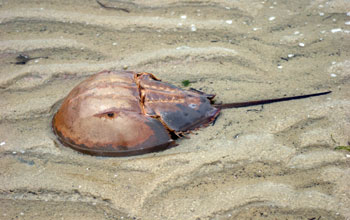News Release 11-102
Replacing the Blue Bloods
Liquid crystal droplets could replace horseshoe crab blood in common endotoxin test

Endotoxin tests currently rely on the blood of horseshoe crabs, which is blue in appearance.
May 19, 2011
View a video showing liquid crystal droplets before and after the addition of endotoxin.
This material is available primarily for archival purposes. Telephone numbers or other contact information may be out of date; please see current contact information at media contacts.
The Food and Drug Administration requires every drug they certify to be tested for certain poisons that damage patient health. The current gold standard for this is the limulus amoebocyte lysate (LAL) assay that involves using the blood of horseshoe crabs, which strangely enough is blue, to test for endotoxin, a substance commonly associated with many symptoms caused by bacterial infections.
But researchers at the Department of Chemical and Biological Engineering at the University of Wisconsin-Madison have found what may be a more effective way to test for endotoxin that involves liquid crystals, the same material used to make some flat screen computer monitors and televisions.
A May 19 article in Science Express describes the finding.
The surprise wasn't that liquid crystals respond to the presence of endotoxin contamination, said Nick Abbott, the John T. and Magdalen L. Sobota professor of engineering at the University of Wisconsin, "but that they respond at such a low concentration--100,000 times lower than you would expect with adsorption. This makes the technology exquisitely sensitive to very low concentrations of endotoxin, and in this instance, very specific to bacterial endotoxin."
Currently, blood is taken from horseshoe crabs using a non-lethal method, but it can cost thousands of dollars per quart, making the test expensive. Due to the biological nature of the test, it is also subject to variations caused by the seasons and other factors that may interact with proteins in the blood.
But the new test gets around those problems. Here is how it works.
Liquid crystals have some of the properties of a liquid and some of a solid. The material can flow like a liquid, but the crystal molecules can line up in a structured way that resembles a solid. Researchers call this "ordering." Ordering is influenced by the surfaces and contaminants the liquid crystals contact.
When studying how certain contaminants influence the ordering of liquid crystal droplets, UW researchers observed something unexpected: the ordering of the crystals is very sensitive to influence by bacterial endotoxin, meaning they could be used to detect the presence of endotoxin.
Additionally, one of the reasons liquid crystals are used in computer and television monitors is because changing their ordering also changes their optical properties. In this instance, that means the liquid crystals look different when endotoxin is present, making for an endotoxin test that is very easy to read.
Researchers stress that this discovery is still in the early stages, and that it could be many years before a commercially available substitute for the LAL assay is fully developed.
"The tremendous gain in sensitivity makes this discovery very exciting," said Mary Galvin of the National Science Foundation's (NSF) Division of Materials Research about the new liquid crystal test. "The work also suggests new principles that may be used for the future design of high sensitivity, low cost sensors that can respond to biological substances."
NSF provided support for this work via the Materials Research Science and Engineering Center (MRSEC) at the University of Wisconsin, which aims to address the science and engineering of nanostructured interfaces. One of three interdisciplinary research groups at this MRSEC, the Nanostructured Interfaces to Biology group is focused on the design and use of polymeric and liquid-crystalline materials.
-NSF-
-
View Video
Liquid crystal droplets (left) look different in the presence of endotoxin (right).
Credit and Larger Version -
The researchers' work is described in the May 19, 2011 issue of Science Express.
Credit and Larger Version
Media Contacts
Lisa Van Pay, NSF, (703) 292-8796, email: lvanpay@nsf.gov
Program Contacts
Mary E. Galvin, NSF, (703) 292-8562, email: mgalvind@nsf.gov
Principal Investigators
Nicholas Abbott, University of Wisconsin, (608) 265-5278, email: abbott@engr.wisc.edu
The U.S. National Science Foundation propels the nation forward by advancing fundamental research in all fields of science and engineering. NSF supports research and people by providing facilities, instruments and funding to support their ingenuity and sustain the U.S. as a global leader in research and innovation. With a fiscal year 2023 budget of $9.5 billion, NSF funds reach all 50 states through grants to nearly 2,000 colleges, universities and institutions. Each year, NSF receives more than 40,000 competitive proposals and makes about 11,000 new awards. Those awards include support for cooperative research with industry, Arctic and Antarctic research and operations, and U.S. participation in international scientific efforts.
Connect with us online
NSF website: nsf.gov
NSF News: nsf.gov/news
For News Media: nsf.gov/news/newsroom
Statistics: nsf.gov/statistics/
Awards database: nsf.gov/awardsearch/
Follow us on social
Twitter: twitter.com/NSF
Facebook: facebook.com/US.NSF
Instagram: instagram.com/nsfgov




